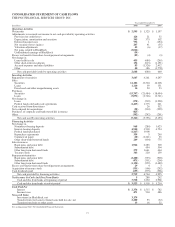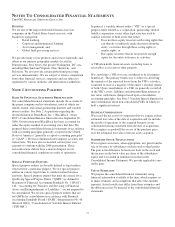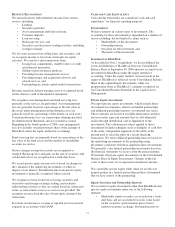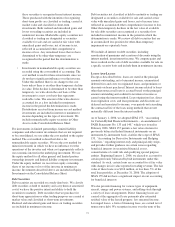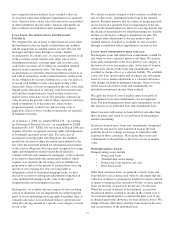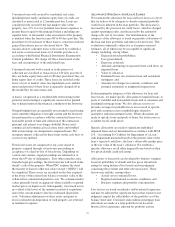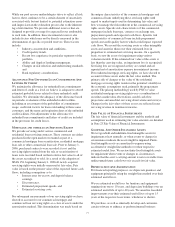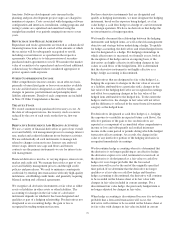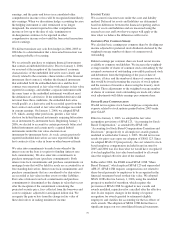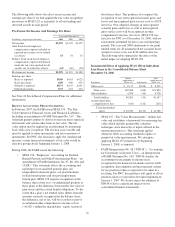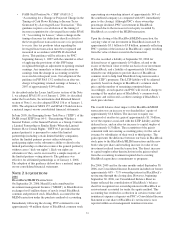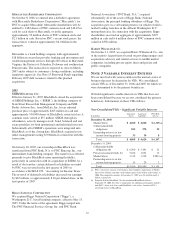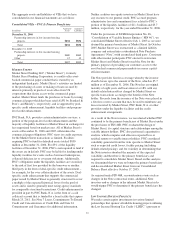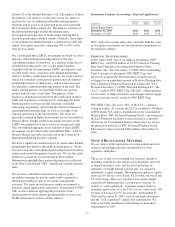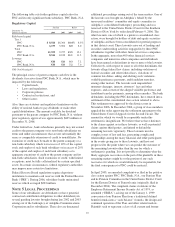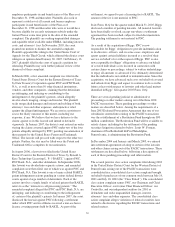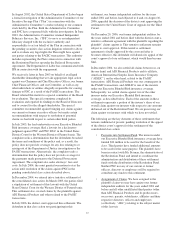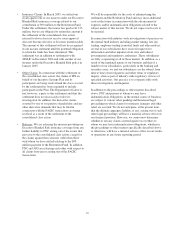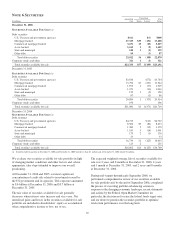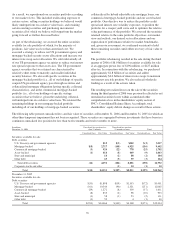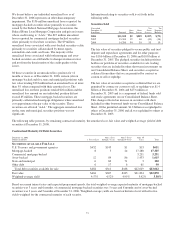PNC Bank 2006 Annual Report Download - page 91
Download and view the complete annual report
Please find page 91 of the 2006 PNC Bank annual report below. You can navigate through the pages in the report by either clicking on the pages listed below, or by using the keyword search tool below to find specific information within the annual report.
• FASB Staff Position No. (“FSP”) FAS 13-2,
“Accounting for a Change or Projected Change in the
Timing of Cash Flows Relating to Income Taxes
Generated by a Leveraged Lease Transaction.” This
guidance requires a recalculation of the timing of
income recognition for a leveraged lease under SFAS
13, “Accounting for Leases,” when a change in the
timing of income tax deductions directly related to
the leveraged lease transaction occurs or is projected
to occur. Any tax positions taken regarding the
leveraged lease transaction must be recognized and
measured in accordance with FIN 48 described
above. This guidance will be effective for PNC
beginning January 1, 2007 with the cumulative effect
of applying the provisions of this FSP being
recognized through an adjustment to opening retained
earnings. Any immediate or future reductions in
earnings from the change in accounting would be
recovered in subsequent years. Our adoption of the
guidance in FSP FAS 13-2 resulted in an after-tax
charge to beginning retained earnings at January 1,
2007 of approximately $149 million.
As described under the Loans And Leases section of the Note
1, we adopted SFAS 155 as of January 1, 2006. As described
under the Loan Sales, Securitizations And Retained Interest
section of Note 1, we also adopted SFAS 156 as of January 1,
2006. The adoption of SFAS 155 and SFAS 156 did not have
a material impact on our consolidated financial statements.
In June 2005, the Emerging Issues Task Force (“EITF”) of the
FASB issued EITF Issue 04-5, “Determining Whether a
General Partner, or the General Partners as a Group, Controls
a Limited Partnership or Similar Entity When the Limited
Partners Have Certain Rights.” EITF 04-5 provides that the
general partner(s) is presumed to control the limited
partnership (including certain limited liability companies),
unless the limited partners possess either substantive
participating rights or the substantive ability to dissolve the
limited partnership or otherwise remove the general partner(s)
without cause (“kick-out rights”). Kick-out rights are
substantive if they can be exercised by a simple majority of
the limited partners voting interests. The guidance was
effective for all limited partnerships as of January 1, 2006.
The adoption of this guidance did not have a material impact
on our consolidated financial statements.
N
OTE
2A
CQUISITIONS
2006
B
LACK
R
OCK
/MLIM T
RANSACTION
On September 29, 2006, Merrill Lynch contributed its
investment management business (“MLIM”) to BlackRock in
exchange for 65 million shares of newly issued BlackRock
common and preferred stock. BlackRock accounted for the
MLIM transaction under the purchase method of accounting.
Immediately following the closing, PNC continued to own
approximately 44 million shares of BlackRock common stock
representing an ownership interest of approximately 34% of
the combined company (as compared with 69% immediately
prior to the closing). Although PNC’s share ownership
percentage declined, PNC’s investment in BlackRock
increased due to the increase in total equity recorded by
BlackRock as a result of the MLIM transaction.
Upon the closing of the BlackRock/MLIM transaction, the
carrying value of our investment in BlackRock increased by
approximately $3.1 billion to $3.8 billion, primarily reflecting
PNC’s portion of the increase in BlackRock’s equity resulting
from the value of shares issued in the transaction.
We also recorded a liability at September 30, 2006 for
deferred taxes of approximately $.9 billion, related to the
excess of the book value over the tax basis of our investment
in BlackRock, and a liability of approximately $.6 billion
related to our obligation to provide shares of BlackRock
common stock to help fund BlackRock long-term incentive
plan (“LTIP”) programs. The LTIP liability will be adjusted
quarterly based on changes in BlackRock’s common stock
price and the number of remaining committed shares.
Accordingly, at each quarter-end PNC will record a charge to
earnings if the market price of BlackRock’s common stock
increases and will record a credit to earnings if BlackRock’s
stock price declines.
The overall balance sheet impact of the BlackRock/MLIM
transaction was an increase to our shareholders’ equity of
approximately $1.6 billion. The increase to equity was
comprised of an after-tax gain of approximately $1.3 billion,
net of the expense associated with the LTIP liability and the
deferred taxes, and an after-tax increase to capital surplus of
approximately $.3 billion. The recognition of the gain is
consistent with our existing accounting policy for the sale or
issuance by subsidiaries of their stock to third parties. The
gain represents the difference between our basis in BlackRock
stock prior to the BlackRock/MLIM transaction and the new
book value per share and resulting increase in value of our
investment realized from the transaction. The direct increase
to capital surplus rather than inclusion in the gain resulted
from the accounting treatment required due to existing
BlackRock repurchase commitments or programs.
For 2004, 2005 and for the nine months ended September 30,
2006, our Consolidated Income Statement included our former
approximately 69% - 71% ownership interest in BlackRock’s
net income through the closing date. However, beginning
September 30, 2006, our Consolidated Balance Sheet no
longer reflected the consolidation of BlackRock’s balance
sheet but recognized our ownership interest in BlackRock as
an investment accounted for under the equity method. This
accounting has resulted in a reduction in certain revenue and
noninterest expense categories on PNC’s Consolidated Income
Statement as our share of BlackRock’s net income is now
reported within asset management noninterest income.
81


